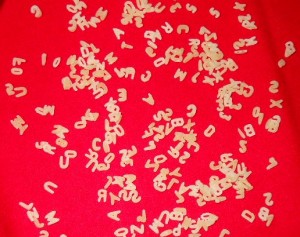Have you ever found yourself wishing you could afford hundreds, or maybe even thousands of letter or number manipulatives? Head for the pasta aisle in your favorite grocery store—a bag of alphabet macaroni contains both letters and numbers! The pasta is low-cost, so if you have several children who would each enjoy their own supply, you can buy several bags. Letting each student store his macaroni in a large zipper bag will help to make clean up simple and easy.
I sorted through a bag just to see if all the letters and numbers were represented, and yes, they were. My adult-sized fingers found the task a little tricky, but a set of tweezers made it simpler. Children’s small fingers are much more suited to this assignment, and tactile learners will really love digging in. Muffin pans, egg cartons, or cookie sheets are great receptacles for sorting!
Let your students play with the uncooked macaroni at first, and see what activities they devise for themselves. If they need a little encouragement or a starting place, suggest sorting the letters, forming spelling words, making random words (like “magnetic poetry” but without the magnets), or writing sentences. If they’d like to save their work, the words can be spelled out on a line of white glue on a piece of cardstock or an index card. The glue will be invisible when dry, and the cardstock can then be cut into appropriate sizes, creating miniature word-cards (add small magnets to the backs of the cards for even more versatility; a steel cookie sheet makes a good lap desk). These cards can be arranged into sentences, poetry, or lists of rhyming words or spelling patterns, and saved in a zipper bag for another day. Be serious, get silly, have fun with nonsense words, or use the letters to form the answers to lesson worksheets, and the learning will take on a whole new dimension. Don’t stop with just phonics, spelling, and grammar, however. Use these letters to practice spelling place names for geography, complicated scientific words for science or chemistry, or important people, places, and events for history. The letters can easily be scooted apart to break words into syllables or prefixes, suffixes, and root words—a great method for word study, and it adds a memory link for better recall later.
The tiny pasta numbers can be used for sorting and matching or set up as math statements by writing operation symbols on paper, leaving blank spaces for the numbers. Select specific numbers or grab random pieces for a new twist on math problems. Younger students will enjoy the challenge of putting the numbers in order or experimenting to see how many different numbers can be formed from just a few digits. Keep the pasta dry and away from toddlers and the family dog, but rest assured that a new supply is readily available in case too many pieces get stepped on, eaten, or sucked up by the vacuum cleaner!



 Guilt-Free Homeschooling is the creation of Carolyn Morrison and her daughter, Jennifer Leonhard. After serious disappointments with public school, Carolyn spent the next 11 years homeschooling her two children, from elementary to high school graduation and college admission. Refusing to force new homeschooling families to re-invent the wheel, Carolyn and Jennifer now share their encouragement, support, tips, and tricks, filling their blog with "all the answers we were looking for as a new-to-homeschooling family" and making this website a valuable resource for parents, not just a daily journal. Guilt-Free Homeschooling -- Equipping Parents for Homeschooling Success!
Guilt-Free Homeschooling is the creation of Carolyn Morrison and her daughter, Jennifer Leonhard. After serious disappointments with public school, Carolyn spent the next 11 years homeschooling her two children, from elementary to high school graduation and college admission. Refusing to force new homeschooling families to re-invent the wheel, Carolyn and Jennifer now share their encouragement, support, tips, and tricks, filling their blog with "all the answers we were looking for as a new-to-homeschooling family" and making this website a valuable resource for parents, not just a daily journal. Guilt-Free Homeschooling -- Equipping Parents for Homeschooling Success!

Speak Your Mind